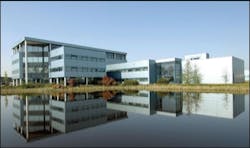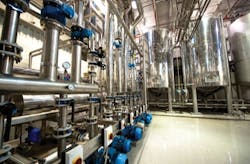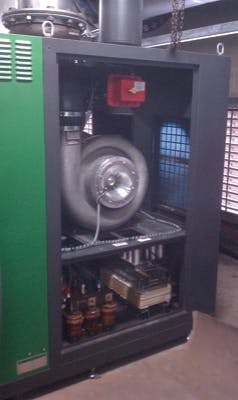Scaled-Up Nitrogen Reduction in Narragansett Bay
The world's largest integrated fixed-film activated sludge (IFAS) process is currently under construction in Providence, RI, and is designed to protect water quality and reduce the amount of nitrogen flowing into Narragansett Bay. The IFAS upgrade will use fixed film systems that allow additional bacterial populations to exist on the surface of floating plastic media in the suspended growth activated sludge process. The project includes a new fine screen system and caustic building, a new carbon building, lift station modifications, aeration capacity upgrades, and IFAS process tank modifications.
By Mark J. Thompson
The world’s largest integrated fixed-film activated sludge (IFAS) process is currently under construction in Providence, RI, in an effort to protect water quality in the region and reduce the amount of nitrogen flowing into Narragansett Bay. The Fields’ Point Wastewater Treatment Facility (WWTF) serves nearly a half-million customers in the metropolitan Providence and Blackstone Valley areas. Its owner, the Narragansett Bay Commission (NBC), initiated a $65 million facility upgrade and retrofit — with the additional stipulation that the wastewater treatment plant continues operating at peak efficiency throughout the four-year effort.
Phased flow
The Fields’ Point WWTF was constructed in the early 1900s. NBC was created in 1980 to manage the wastewater utility that provides an average daily flow of 50 mgd with a secondary treatment design capacity of 77 mgd.
The IFAS upgrade will use fixed film systems that allow additional bacterial populations to exist on the surface of floating plastic media in the suspended growth activated sludge process, thereby eliminating the need to increase the bioreactor volume and saving significant capital cost.
Converting a conventional wastewater treatment plant to IFAS technology requires the addition of a number of different treatment systems, including a new fine screening and caustic building, a new carbon building, lift station modifications, aeration capacity upgrades, and IFAS process tank modifications.
Screens, Pumps
All IFAS systems require adequate preliminary treatment design and operation. Primary clarification and fine screening prevents ragging and material build-up on the media in the aeration basin and clogging of the dispersed media and retaining screens/sieves.
Therefore, key in the upgrade is the construction of a new 5,000-square-foot screening and caustic building next to the existing screw pumps and blower building. The fine screening process removes particulates larger than 6 mm from the process flow while the caustic chemical feed facility doses caustic soda (50 percent sodium hydroxide) for maintaining adequate pH.
Sufficient oxygen must be available to satisfy the demand of the additional biomass to oxidize biological oxygen and ammonia. The blower building currently incorporates an existing 30-inch air header, not enough to supply oxygen for the increased treatment. The existing aeration capacity was also evaluated to determine whether it is adequate for the increased biological nitrogen removal and biomass respiration expected with the higher level of treatment performance associated with IFAS.
The upgrade will include the installation of a second 36-inch air header and nine turbo blowers. To accomplish this upgrade, the client and engineer of record worked together to procure turbo blowers, a relatively new technology, saving the agency significant costs by avoiding the need to build an expansion to the existing blower building, which would have been required using conventional blower technology.
Supplemental Carbon
The new chemical storage and pumping equipment will provide supplemental carbon from a new 2,000-square-foot building. Supplemental carbon is necessary for the biological nitrogen removal process.
The engineering team designed the adjacent chemical tank farm, a concrete structure that supports several large chemical storage tanks and provides containment walls in the event of a chemical spill. The facility design meets fire safety code for storage and handling methanol, though the owner may elect to use a manufactured carbon source that is not flammable.
IFAS Systems
Media installation needs to be planned carefully to ensure that the existing basins can accommodate the dispersed media systems. The engineering team designed significant structural and mechanical modifications to the 10 existing aeration tanks to accommodate the IFAS process.
Process modifications added alternating anoxic and oxygenated treatment zones to reduce nitrogen from the process. The project will also install mixing systems, process pumping, and upgrades to the froth spray system. Structural engineers designed new 20-foot cast-in-place concrete tank baffle walls, as well as new fiberglass tank baffle walls and equipment platforms.
Other upgrade components include:
• Grit classifiers (capacity doubled)
• Primary scum handling (capacity doubled)
• Plant water system optimized
• Primary (4) and secondary clarifiers (6)
• Mechanical collection systems for gravity sludge thickeners (3)
• Electrical systems and standby generator
As part of the bid documents, engineers developed a detailed construction-phasing plan for the entire project upgrade to ensure that the facility continues to operate and treat wastewater effectively during construction. The construction phasing plan provided the contractor with operations-related work restrictions, as well as construction optimization suggestions, and saved the client $1.5 million in bypass pumping alone.
Energy Conservation
This project includes a new 25,000-square-foot, three-story operations and administration building that will house modern amenities, including a facility control room and public educational areas and resources. The building is designed to meet the U.S. Green Building Council (USGBC) LEED Silver standard.
Green elements of the building include, but are not limited to, reduced water consumption by using plant water for toilet flushing, a green roof, use of natural day lighting to limit the need for artificial lighting, high efficiency building mechanical systems and robust stormwater handling strategies. The building design complies with the latest wind and seismic code requirements and uses a concrete foundation system, structural steel superstructure, and glass and masonry exterior walls.
All new buildings — administrative, screening and caustic, and the carbon feed building — were designed to complement adjacent existing buildings in order to achieve the consistent appearance of an integrated campus. Architects designed all building exteriors with brick masonry walls and a gable roof to accomplish consistency with older buildings at the facility.
Fields’ Point, on track to be the world’s largest WWTF using the IFAS process, is currently under construction with a target completion date of early 2013.
WW
About the Author: Mark J. Thompson is a principal engineer with Kleinfelder and was the project manager on the Field’s Point project. He can be reached at [email protected].
More WaterWorld Current Issue Articles
More WaterWorld Archives Issue Articles



